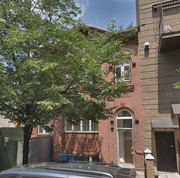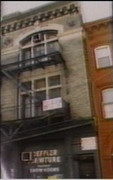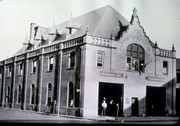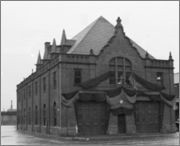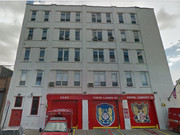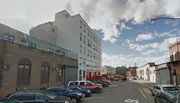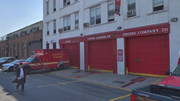Engine 211/Ladder 119 firehouse 26 Hooper Street Williamsburg, Brooklyn Division 11, Battalion 31 "Victory Engine"
Engine 11 BFD organized 173 Clymer Street former volunteer firehouse 1869
Engine 11 BFD new firehouse 166 Clymer Street 1888
Engine 11 BFD became Engine 11 FDNY 1898
Engine 11 became Engine 111 1899
Engine 111 moved to 190 Clymer Street 1909
Engine 111 new firehouse 166 Clymer Street 1910
Engine 111 became Engine 211 1913
Engine 211 new firehouse 26 Hooper Street w/Ladder 119 1944
Ladder 69 organized 47/48 Washington Avenue at Engine 151 1901
Ladder 69 became Ladder 119 1913
Ladder 119 moved to 160 Carlton Avenue at Engine 210 1941
Ladder 119 new firehouse 26 Hooper Street w/ Engine 211 1944
Engine 251 located at 26 Hooper Street w/Engine 211 1944-1946
Division 11 located at 166 Clymer Street at Engine 211 1927-1930
Division 11 located at 26 Hooper Street at Engine 211 1948-1951
Superpumper 1 organized at 26 Hooper Street at Engine 211 1965
Superpumper 1 moved to 172 Tillery Street at Engine 207 1972
Superpumper 1 disbanded 1975
Supertender 1 organized at 26 Hooper Street at Engine 211 1965
Supertender 1 moved to 172 Tillery Street at Engine 207 1972
Supertender 1 disbanded 1975
Satellite 1 organized and located at 26 Hooper Street at Engine 211 1965
Ladder 104 located at 166 Clymer Street at Engine 211 1931-1932
Water Tower 5 located at 47/48 Washington Avenue at Engine 251/Ladder 119 1932
Pre-Brooklyn Fire Department - volunteer Victory Engine 13:
Former firehouse 173 Clymer Street
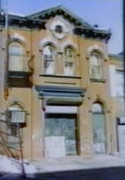
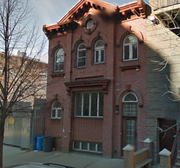
Disbanded 1869
Firehouse became initial quarters of Engine 11 BFD
Members enlisted in 1861 for service during Civil War - formed Company H, 13th NY Regiment
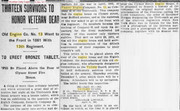
Brooklyn Fire Department:
ENGINE COMPANY NO. 11 ON HAND AT ALL GREAT FIRES
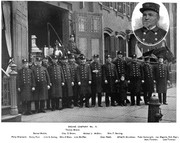
Engine Company No. 11 was organized on Sept. 15, 1869, and is quartered in a brick house with brownstone trimmings on Clymer Street, near Bedford Avenue. Prior to the organization of the uniformed force, Victory Engine Company No. 13, of the Volunteer Department, had their quarters on the site of the present building, and after the disbandment of that company, and upon the formation of Engine Company No. 11, the latter occupied the old house up to the year 1888, when the present engine-house was erected. The apparatus of this company consists of a second-class Amoskeag engine, and a four-wheeled tender. The engine horses are both fine, large bays and their driver calls them ?Bill'' and "Sam." The team for the tender consists of a black horse, "Mike," who is extremely docile and a very steady worker. His mate is "Charlie," a large, fine-looking dapple-gray, who is very frisky, but not at all vicious.
While resisting the shoeing process in December, 1890, he dislocated the right arm and shoulder of Driver William M. O'BRIEN, who was using his best efforts to quiet the animal. "Charlie" is also credited with having kicked Fireman James Sylvester PRYOR and breaking his knee cap in November last, but the verdict of the company declared it fit to be a case of "accidental kicking." PRYOR is still on the sick list. There is another stall in the engine-house, occupied by a little black horse called "Jim," who was a great favorite of the late District Engineer George A. FROST, and the horse seems to miss him as much as do the men with whom Mr. FROST was daily associated. As to the men who compose the company, they are as brave a lot as the Fire Department of Brooklyn can boast. They respond to calls from 81 boxes on a first-alarm, and 82 additional on a second-alarm.
Among the buildings of note in the Eastern District over which the company have to keep strict surveillance are the Amphion, Lee Avenue Academy, the Novelty and Bedford Avenue theatres, and the Grand Museum, Christ P. E. Church; the First Reformed Church, St. John's M. E. Church, the Ross Street Presbyterian Church St. Peter's and St. Paul's Roman Catholic Church, the RC Church of the Transfiguration, the Lee Avenue Congregational Church, and the First Baptist Church. Within the boundaries of their district also are eight public schools, Nos 16, 17, 19, 33, 37, 38, 48 and 50. Besides these, there are many places of business, some of them from seven to ten stones in height. Among the latter are Pratt's oil works, and the sugar refineries of Havemeyer & Company. Brooklyn Sugar Refining Company, De Castro & Donner, Moeller & Sierck, and J.A. Mullenhauer. The districts includes also the Wallabout Market, Grand Bazaar, American Cocoa-matting Company, Smith & Gray clothing house. Birch's paint works. Cross & Austin's lumber yard Healy's iron works, Paul Wiedman's brewery and Dunlap's hat factory.
At all the great fires in the Eastern District, at which property has been destroyed in amounts ranging from $100,000 to $1,000,000, the boys of No. 11 have taken a very active part. Some of the larger fires at which the company has worked are those in the Heckler Iron Works, a block of flat-houses on Nostrand Avenue, Church's soda water factory, Dick & Meyer's sugar works, the Commercial Street sugar works Wiedman's cooperage, Palmer's cooperage, Waterbury rope walk, Pratt's oil works, Dunlaps hat factory, the Planet Mills, the fire on Court Street during the water famine Hyde & Behman's theatre, the American Cocoa-matting Company, Sone & Fleming's oil works, at which two firemen were burned to death; Jennings oil works, Wallabout Market; a fire at the foot of Clymer Street, at which several hay barges were burned the Delmonico Place fire, at which a woman and child were burned to death; Mason's furniture factory, the Adelphi Academy, the Marine Hospital, Kennedy's machine shop, the lubricating oil works on Steuben Street; and the fire at Pierrepont stores, at which three ships, two lighters and several hundred feet of warfage were destroyed, and several firemen were overcome with the fumes of burning jute butts. The company members particularly remember the fire at Lewis' mat factor, at Lorimer and McKibben Streets on the day of the blizzard of 1888, for they went to the fire with the engine runners, and one of the horses was stuck in a snow-drift and died soon after from the effects of the exposure. They remember, too, the fire at the Bushwick car stables in which 100 horses were suffocated or burned to death. They call to memory with feelings of sadness the Herseman bakery fire at Power's Street and Graham Avenue on June 23, 1884, at which Jonathan TYACK, Acting Foreman of Hook and Ladder Company No. 6, and George W. HAIGHT of Engine Company No. 15, were killed by failing walls; and they also vividly recall the terrible loss of life occasioned by the fire at St. John's Orphan Asylum, in the winter of 1883-4. The last big fire to which they responded on a special call was that in the Smith, Gray & Company building at the junction of Fulton Street and Flatbush Avenue.
Assistant Foreman PETER WILLIAM CARTWRIGHT was born in County Kildare, Ireland, on March 31, 1844. He served five years in the Volunteer Fire Department with "Northern Liberties," Engine No. 5, and on Aug. 1, 1870, was appointed to the uniformed force and assigned to Hook and Ladder No. 6. He remained with this company for a few weeks only and was then transferred to Engine No. 12, where he remained for nineteen years. On July 1, 1889, he was promoted to the grade of Assistant Foreman and assigned to duty with Engine No. 11, where he has since remained. Mr. CARTWRIGHT was in charge of Engine No. 12, during the fire at Donald's oil works on Sept. 15, 1882, when Charles KEEGAN, a member of the company, was burned to death. While responding to an alarm of fire on June 23, 1890, the engine struck an iron column of the Elevated Railroad at Johnson Avenue and Broadway and Mr. CARTWRIGHT was thrown off and had his collar-bone broken. Mr. CARTWRIGHT is married and lives with his family at No. 104 North Ninth Street.
Engineer ALFRED ELY GRUNDMAN was born in New York City, on Dec. 14, 1838. He was an engineer in the Volunteer Department from 1857 till 1869, when he became a member of the uniformed force and was assigned to duty with the company to which he is now attached. He is temporarily detailed to the Repair Shops.
Assistant Engineer PHILIP WISCHERTH was born in New York City on Feb. 17, 1859. He is single, and lives at No. 12 Locust Street. He was appointed on Jan. 30, 1882, and assigned to Engine No. 12, where he remained for one year, and was then transferred to Engine No. 11. From this company he was transferred to Engine No. 21, and after two years' service with that company, was sent back to No. 11. While responding to an alarm of fire in 1884, the tender on which he was riding broke down and he had his leg badly injured.
CHARLES E. BROWN was born in Calais, Maine, on April 18, 1854. He is married, and lives at No. 247 Lee Avenue. In his younger days he went on a whaling voyage. For seven years he served in the merchant marine service, and also served as a seaman in the navy on the "Yantic" and "Nipsic". He became a fireman on Jan. 1, 1887. He was for short periods attached to Engine No. 13 and Hook and Ladder No. 6. Mr. BROWN had a terrible experience on Feb. 5, 1890 at the burning of the American cocoa-matting factory on Walworth Street, from which building he escaped after being nearly suffocated and having his hands, arms and face badly burned.
WILLIAM McCLEARY, whose life was saved by the heroic efforts of Foreman MCGUIRE at the American cocoa-matting fire, was born in this city on Jan. 30, 1858. He is married and lives at No. 163 Lee Avenue. He was appointed on April 1, 1885, and assigned to Engine No. 11, where he did active duty until the time of the fire. His hands were so badly burned at that time that he can no longer do active duty work and he is now detailed to duty at the Bell Tower, at North First Street and Bedford Avenue.
Driver WILLIAM M. OBRIEN was born in Williamsburg on Dec. 27, 1841. From May 19, 1862, till April 23, 1865. he served in the United States Navy on board the war vessels "Adirondack" and "Memphis." He was appointed a fireman on Sept 15, 1869, and on Dec. 21, 1871, was promoted to the grade of driver and assigned to the company he is now attached to. He had his right arm and shoulder dislocated by one of the tender horses on Dec. 29, 1890, and still feels the effects of the injury Mr. OBRIEN rescued Mrs. Jane TAYLOR from the top floor of No. 363 South First Street in Apr, 1887. Mr. OBRIEN's home was nearly opposite the house in which Mrs. TAYLOR Lived. He was looking out of his window and saw flames coming out of the window of Mrs. TAYLOR's room. He seized his heavy overcoat, rushed across the street, burst open the door of the woman's room and found her enveloped in flames and unconscious. He threw his coat about her and smothered the flames, and in doing so scorched his hands and arms. Mrs. TAYLOR was taken to the hospital, where she afterward died from her injuries. Mr. OBRIEN is an old volunteer fireman and was attached to Protection Engine No. 2. He is married and lives at No. 350 South First Street.
JAMES SYLVESTER PRTOR was born in the Fourteenth Ward on May 9,1855 He was appointed on Feb. 17. 1887, and assigned to Engine Company No. 17 where he remained one month and was then transferred to Engine Company No. 11. While acting as driver of the steamer on Nov. 29 last he had his knee cap broken by a kick from one of the tender horses, which disabled him for many months.
SAMUEL H MADOLE was born in Williamsburg, on Dec. 19, 1841. He saw active service with the 84th N. Y. Volunteers in the late war, and was disabled at building of Fort Cass on Arlington Heights. On his return from the army he joined the Volunteer Fire Department. He was appointed to the uniformed force on April 20, 1878, and since that time has done service with Engine Companies Nos. 16, 22, and 11. While doing active duty at a fire in Kennedy's machine-shop at North Third Street and Kent Avenue, he fell down an open hatch into the sub cellar and received severe injuries to his arms and back. While going to another fire the tender broke down and his spine was injured. Later he was thrown from the back of one of the fire horses and had his head injured. During the large fire at Watson's stores he was overcome with smoke from the burning jute butts and was laid up for several days in the Brooklyn Hospital. Mr. MADOLE is a widower, and has a grown up son and daughter with whom he resides at No. 208 Rodney Street.
Isaac Brower GEISCHARD was born in this city, Dec. 22, 1838. He served his country in the Civil War for one hundred days with Company H. l3th Regiment, N. G. S. N. Y., and subsequently served six years with Washington Engine No. 1 of the Volunteer Department. He received his appointment as fireman on April 23, 1872, and has since done duty with Engine No. 11. He is the stoker of the engine.
HENRY J. PAUL was born in England on Nov. 11, 1836, and was appointed a fireman on Aug. 3, 1875. . He has done active service with Engine Companies Nos. 16 and 11, and, being a mason by trade, is now detailed at Fire Headquarters to make such repairs in the engine-houses as are needed in his line.
JOHN STRIFFLER was appointed on March 23, 1891 and assigned to Engine No. 21. In February, 1892 he was detailed to Engine Company No. 11, where he has since shown himself to be a courageous, efficient member of the force. At the Nostrand Avenue flat-house fire in December, 1891, Mr. STRIMER with the assistance of Fireman Richard BROWN rescued District Engineer FANNING when he fell through the roof. He was born in New York City, on Oct. 9, 1865, is a married man and lives at No. 154 Varet Street.
PATRICK J. MEAGHER was born in Brooklyn on Sept. 23, 1863. Prior to his appointment to the uniformed force, on July 1, 1892, he was a driver for C.H. Reynolds.
Engine 11 BFD organized 173 Clymer Street former volunteer firehouse 1869
Engine 11 BFD new firehouse 166 Clymer Street 1888
Engine 11 BFD became Engine 11 FDNY 1898
Engine 11 became Engine 111 1899
Engine 111 moved to 190 Clymer Street 1909
Engine 111 new firehouse 166 Clymer Street 1910
Engine 111 became Engine 211 1913
Engine 211 new firehouse 26 Hooper Street w/Ladder 119 1944
Ladder 69 organized 47/48 Washington Avenue at Engine 151 1901
Ladder 69 became Ladder 119 1913
Ladder 119 moved to 160 Carlton Avenue at Engine 210 1941
Ladder 119 new firehouse 26 Hooper Street w/ Engine 211 1944
Engine 251 located at 26 Hooper Street w/Engine 211 1944-1946
Division 11 located at 166 Clymer Street at Engine 211 1927-1930
Division 11 located at 26 Hooper Street at Engine 211 1948-1951
Superpumper 1 organized at 26 Hooper Street at Engine 211 1965
Superpumper 1 moved to 172 Tillery Street at Engine 207 1972
Superpumper 1 disbanded 1975
Supertender 1 organized at 26 Hooper Street at Engine 211 1965
Supertender 1 moved to 172 Tillery Street at Engine 207 1972
Supertender 1 disbanded 1975
Satellite 1 organized and located at 26 Hooper Street at Engine 211 1965
Ladder 104 located at 166 Clymer Street at Engine 211 1931-1932
Water Tower 5 located at 47/48 Washington Avenue at Engine 251/Ladder 119 1932
Pre-Brooklyn Fire Department - volunteer Victory Engine 13:
Former firehouse 173 Clymer Street


Disbanded 1869
Firehouse became initial quarters of Engine 11 BFD
Members enlisted in 1861 for service during Civil War - formed Company H, 13th NY Regiment

Brooklyn Fire Department:
ENGINE COMPANY NO. 11 ON HAND AT ALL GREAT FIRES

Engine Company No. 11 was organized on Sept. 15, 1869, and is quartered in a brick house with brownstone trimmings on Clymer Street, near Bedford Avenue. Prior to the organization of the uniformed force, Victory Engine Company No. 13, of the Volunteer Department, had their quarters on the site of the present building, and after the disbandment of that company, and upon the formation of Engine Company No. 11, the latter occupied the old house up to the year 1888, when the present engine-house was erected. The apparatus of this company consists of a second-class Amoskeag engine, and a four-wheeled tender. The engine horses are both fine, large bays and their driver calls them ?Bill'' and "Sam." The team for the tender consists of a black horse, "Mike," who is extremely docile and a very steady worker. His mate is "Charlie," a large, fine-looking dapple-gray, who is very frisky, but not at all vicious.
While resisting the shoeing process in December, 1890, he dislocated the right arm and shoulder of Driver William M. O'BRIEN, who was using his best efforts to quiet the animal. "Charlie" is also credited with having kicked Fireman James Sylvester PRYOR and breaking his knee cap in November last, but the verdict of the company declared it fit to be a case of "accidental kicking." PRYOR is still on the sick list. There is another stall in the engine-house, occupied by a little black horse called "Jim," who was a great favorite of the late District Engineer George A. FROST, and the horse seems to miss him as much as do the men with whom Mr. FROST was daily associated. As to the men who compose the company, they are as brave a lot as the Fire Department of Brooklyn can boast. They respond to calls from 81 boxes on a first-alarm, and 82 additional on a second-alarm.
Among the buildings of note in the Eastern District over which the company have to keep strict surveillance are the Amphion, Lee Avenue Academy, the Novelty and Bedford Avenue theatres, and the Grand Museum, Christ P. E. Church; the First Reformed Church, St. John's M. E. Church, the Ross Street Presbyterian Church St. Peter's and St. Paul's Roman Catholic Church, the RC Church of the Transfiguration, the Lee Avenue Congregational Church, and the First Baptist Church. Within the boundaries of their district also are eight public schools, Nos 16, 17, 19, 33, 37, 38, 48 and 50. Besides these, there are many places of business, some of them from seven to ten stones in height. Among the latter are Pratt's oil works, and the sugar refineries of Havemeyer & Company. Brooklyn Sugar Refining Company, De Castro & Donner, Moeller & Sierck, and J.A. Mullenhauer. The districts includes also the Wallabout Market, Grand Bazaar, American Cocoa-matting Company, Smith & Gray clothing house. Birch's paint works. Cross & Austin's lumber yard Healy's iron works, Paul Wiedman's brewery and Dunlap's hat factory.
At all the great fires in the Eastern District, at which property has been destroyed in amounts ranging from $100,000 to $1,000,000, the boys of No. 11 have taken a very active part. Some of the larger fires at which the company has worked are those in the Heckler Iron Works, a block of flat-houses on Nostrand Avenue, Church's soda water factory, Dick & Meyer's sugar works, the Commercial Street sugar works Wiedman's cooperage, Palmer's cooperage, Waterbury rope walk, Pratt's oil works, Dunlaps hat factory, the Planet Mills, the fire on Court Street during the water famine Hyde & Behman's theatre, the American Cocoa-matting Company, Sone & Fleming's oil works, at which two firemen were burned to death; Jennings oil works, Wallabout Market; a fire at the foot of Clymer Street, at which several hay barges were burned the Delmonico Place fire, at which a woman and child were burned to death; Mason's furniture factory, the Adelphi Academy, the Marine Hospital, Kennedy's machine shop, the lubricating oil works on Steuben Street; and the fire at Pierrepont stores, at which three ships, two lighters and several hundred feet of warfage were destroyed, and several firemen were overcome with the fumes of burning jute butts. The company members particularly remember the fire at Lewis' mat factor, at Lorimer and McKibben Streets on the day of the blizzard of 1888, for they went to the fire with the engine runners, and one of the horses was stuck in a snow-drift and died soon after from the effects of the exposure. They remember, too, the fire at the Bushwick car stables in which 100 horses were suffocated or burned to death. They call to memory with feelings of sadness the Herseman bakery fire at Power's Street and Graham Avenue on June 23, 1884, at which Jonathan TYACK, Acting Foreman of Hook and Ladder Company No. 6, and George W. HAIGHT of Engine Company No. 15, were killed by failing walls; and they also vividly recall the terrible loss of life occasioned by the fire at St. John's Orphan Asylum, in the winter of 1883-4. The last big fire to which they responded on a special call was that in the Smith, Gray & Company building at the junction of Fulton Street and Flatbush Avenue.
Assistant Foreman PETER WILLIAM CARTWRIGHT was born in County Kildare, Ireland, on March 31, 1844. He served five years in the Volunteer Fire Department with "Northern Liberties," Engine No. 5, and on Aug. 1, 1870, was appointed to the uniformed force and assigned to Hook and Ladder No. 6. He remained with this company for a few weeks only and was then transferred to Engine No. 12, where he remained for nineteen years. On July 1, 1889, he was promoted to the grade of Assistant Foreman and assigned to duty with Engine No. 11, where he has since remained. Mr. CARTWRIGHT was in charge of Engine No. 12, during the fire at Donald's oil works on Sept. 15, 1882, when Charles KEEGAN, a member of the company, was burned to death. While responding to an alarm of fire on June 23, 1890, the engine struck an iron column of the Elevated Railroad at Johnson Avenue and Broadway and Mr. CARTWRIGHT was thrown off and had his collar-bone broken. Mr. CARTWRIGHT is married and lives with his family at No. 104 North Ninth Street.
Engineer ALFRED ELY GRUNDMAN was born in New York City, on Dec. 14, 1838. He was an engineer in the Volunteer Department from 1857 till 1869, when he became a member of the uniformed force and was assigned to duty with the company to which he is now attached. He is temporarily detailed to the Repair Shops.
Assistant Engineer PHILIP WISCHERTH was born in New York City on Feb. 17, 1859. He is single, and lives at No. 12 Locust Street. He was appointed on Jan. 30, 1882, and assigned to Engine No. 12, where he remained for one year, and was then transferred to Engine No. 11. From this company he was transferred to Engine No. 21, and after two years' service with that company, was sent back to No. 11. While responding to an alarm of fire in 1884, the tender on which he was riding broke down and he had his leg badly injured.
CHARLES E. BROWN was born in Calais, Maine, on April 18, 1854. He is married, and lives at No. 247 Lee Avenue. In his younger days he went on a whaling voyage. For seven years he served in the merchant marine service, and also served as a seaman in the navy on the "Yantic" and "Nipsic". He became a fireman on Jan. 1, 1887. He was for short periods attached to Engine No. 13 and Hook and Ladder No. 6. Mr. BROWN had a terrible experience on Feb. 5, 1890 at the burning of the American cocoa-matting factory on Walworth Street, from which building he escaped after being nearly suffocated and having his hands, arms and face badly burned.
WILLIAM McCLEARY, whose life was saved by the heroic efforts of Foreman MCGUIRE at the American cocoa-matting fire, was born in this city on Jan. 30, 1858. He is married and lives at No. 163 Lee Avenue. He was appointed on April 1, 1885, and assigned to Engine No. 11, where he did active duty until the time of the fire. His hands were so badly burned at that time that he can no longer do active duty work and he is now detailed to duty at the Bell Tower, at North First Street and Bedford Avenue.
Driver WILLIAM M. OBRIEN was born in Williamsburg on Dec. 27, 1841. From May 19, 1862, till April 23, 1865. he served in the United States Navy on board the war vessels "Adirondack" and "Memphis." He was appointed a fireman on Sept 15, 1869, and on Dec. 21, 1871, was promoted to the grade of driver and assigned to the company he is now attached to. He had his right arm and shoulder dislocated by one of the tender horses on Dec. 29, 1890, and still feels the effects of the injury Mr. OBRIEN rescued Mrs. Jane TAYLOR from the top floor of No. 363 South First Street in Apr, 1887. Mr. OBRIEN's home was nearly opposite the house in which Mrs. TAYLOR Lived. He was looking out of his window and saw flames coming out of the window of Mrs. TAYLOR's room. He seized his heavy overcoat, rushed across the street, burst open the door of the woman's room and found her enveloped in flames and unconscious. He threw his coat about her and smothered the flames, and in doing so scorched his hands and arms. Mrs. TAYLOR was taken to the hospital, where she afterward died from her injuries. Mr. OBRIEN is an old volunteer fireman and was attached to Protection Engine No. 2. He is married and lives at No. 350 South First Street.
JAMES SYLVESTER PRTOR was born in the Fourteenth Ward on May 9,1855 He was appointed on Feb. 17. 1887, and assigned to Engine Company No. 17 where he remained one month and was then transferred to Engine Company No. 11. While acting as driver of the steamer on Nov. 29 last he had his knee cap broken by a kick from one of the tender horses, which disabled him for many months.
SAMUEL H MADOLE was born in Williamsburg, on Dec. 19, 1841. He saw active service with the 84th N. Y. Volunteers in the late war, and was disabled at building of Fort Cass on Arlington Heights. On his return from the army he joined the Volunteer Fire Department. He was appointed to the uniformed force on April 20, 1878, and since that time has done service with Engine Companies Nos. 16, 22, and 11. While doing active duty at a fire in Kennedy's machine-shop at North Third Street and Kent Avenue, he fell down an open hatch into the sub cellar and received severe injuries to his arms and back. While going to another fire the tender broke down and his spine was injured. Later he was thrown from the back of one of the fire horses and had his head injured. During the large fire at Watson's stores he was overcome with smoke from the burning jute butts and was laid up for several days in the Brooklyn Hospital. Mr. MADOLE is a widower, and has a grown up son and daughter with whom he resides at No. 208 Rodney Street.
Isaac Brower GEISCHARD was born in this city, Dec. 22, 1838. He served his country in the Civil War for one hundred days with Company H. l3th Regiment, N. G. S. N. Y., and subsequently served six years with Washington Engine No. 1 of the Volunteer Department. He received his appointment as fireman on April 23, 1872, and has since done duty with Engine No. 11. He is the stoker of the engine.
HENRY J. PAUL was born in England on Nov. 11, 1836, and was appointed a fireman on Aug. 3, 1875. . He has done active service with Engine Companies Nos. 16 and 11, and, being a mason by trade, is now detailed at Fire Headquarters to make such repairs in the engine-houses as are needed in his line.
JOHN STRIFFLER was appointed on March 23, 1891 and assigned to Engine No. 21. In February, 1892 he was detailed to Engine Company No. 11, where he has since shown himself to be a courageous, efficient member of the force. At the Nostrand Avenue flat-house fire in December, 1891, Mr. STRIMER with the assistance of Fireman Richard BROWN rescued District Engineer FANNING when he fell through the roof. He was born in New York City, on Oct. 9, 1865, is a married man and lives at No. 154 Varet Street.
PATRICK J. MEAGHER was born in Brooklyn on Sept. 23, 1863. Prior to his appointment to the uniformed force, on July 1, 1892, he was a driver for C.H. Reynolds.

